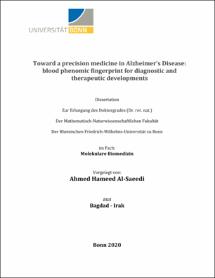Toward a precision medicine in Alzheimer’s Disease: blood phenomic fingerprint for diagnostic and therapeutic developments

Toward a precision medicine in Alzheimer’s Disease: blood phenomic fingerprint for diagnostic and therapeutic developments

| dc.contributor.advisor | Schultze, Joachim L. | |
| dc.contributor.author | Al-Saeedi, Ahmed Hameed | |
| dc.date.accessioned | 2020-05-05T09:40:17Z | |
| dc.date.available | 2021-05-15T22:00:30Z | |
| dc.date.issued | 05.05.2020 | |
| dc.identifier.uri | https://hdl.handle.net/20.500.11811/8350 | |
| dc.description.abstract | There is an unmet clinical need to identify reliable blood biomarkers for Alzheimer’s Disease (AD) that can be used for diagnostics and therapeutic purposes. The complex nature of AD, single-readout approaches along with the inter-individual variation are among the major challenges for developing biomarkers towards stratification of AD patients. A multi-parametric immune-based assay combined with the rapidly advancing machine learning multivariate analysis presents itself as a powerful approach for blood-based disease detection. In this study, peripheral blood mononuclear cells (PBMCs) have been used as a proxy for the peripheral immune changes in disease and healthy groups. Our PBMC ex vivo assay monitors the activities of the Toll Like Receptor (TLR) and the inflammasome as well as it provides a platform to characterize the gene expression profile using (RNA-seq) as well as the cellular composition. TLR and inflammasome activities were monitored via a high-content phenotypic assay, cell profiling and imaging-based approaches, flanked by a homogeneous readout, i.e. cytokine assay. The utilized multi-readouts workflow enables a detailed phenotypic description for the PBMC samples, aiming to identify a phenotype fingerprint that could be used in early diagnosis of the disease. The cell-based assay was designed to overcome challenges associated with the heterogeneous pathological phenotype resulting from variable immune system responses using an automated platform of DZNE Bonn to scale-up the assay capacity and improving its reproducibility. The assay was validated against day-to-day variations and further enhanced by introducing a time-lapse analysis showing that differential response of monocyte, but not T or B cells, to the inflammasome activation. Moreover, an image-based analysis was established to characterize the cellular composition of investigated samples using a supervised neural U-Net-based pixel classifier. The established PBMC assay was used to analyze a small pilot cohort of 20 patients (AD + depression + psychiatric controls) + three samples of healthy donors. The assay readouts were integrated into a feature vector analyzed with Support Vector Machine classifier in order to help in predicting the disease status for each of the tested samples. The predictive model provides an excellent platform with an estimated 91% accuracy. The classifier precisely predicted and dissected the Samples of AD patients (n=6) from depressed samples (n=5). Furthermore, the classifier assigned the most important features (readouts) for disease prediction, e.g. intracellular TNF production, that could be investigated for further therapeutic development. Nevertheless, the workflow needs to be validated with a larger cohort of AD patients as well as other immune related diseases in order to validate the selectivity and specificity of the platform. our PBMC workflow has a huge potential to be a key tool towards precision medicine in AD by patient stratification via immune phenotyping. | en |
| dc.language.iso | eng | |
| dc.rights | In Copyright | |
| dc.rights.uri | http://rightsstatements.org/vocab/InC/1.0/ | |
| dc.subject | Alzheimer's Disease | |
| dc.subject | Inflammasome | |
| dc.subject | Neuroinflammation | |
| dc.subject | Multivariate analysis | |
| dc.subject | Machine learning | |
| dc.subject.ddc | 570 Biowissenschaften, Biologie | |
| dc.subject.ddc | 610 Medizin, Gesundheit | |
| dc.title | Toward a precision medicine in Alzheimer’s Disease: blood phenomic fingerprint for diagnostic and therapeutic developments | |
| dc.type | Dissertation oder Habilitation | |
| dc.publisher.name | Universitäts- und Landesbibliothek Bonn | |
| dc.publisher.location | Bonn | |
| dc.rights.accessRights | openAccess | |
| dc.identifier.urn | https://nbn-resolving.org/urn:nbn:de:hbz:5-58253 | |
| ulbbn.pubtype | Erstveröffentlichung | |
| ulbbnediss.affiliation.name | Rheinische Friedrich-Wilhelms-Universität Bonn | |
| ulbbnediss.affiliation.location | Bonn | |
| ulbbnediss.thesis.level | Dissertation | |
| ulbbnediss.dissID | 5825 | |
| ulbbnediss.date.accepted | 23.03.2020 | |
| ulbbnediss.institute | Angegliederte Institute, verbundene wissenschaftliche Einrichtungen : Deutsches Zentrum für Neurodegenerative Erkrankungen (DZNE) | |
| ulbbnediss.fakultaet | Mathematisch-Naturwissenschaftliche Fakultät | |
| dc.contributor.coReferee | Schneider, Anja | |
| ulbbnediss.date.embargoEndDate | 15.05.2021 | |
| ulbbnediss.contributor.gnd | 1235262553 |
Dateien zu dieser Ressource
Das Dokument erscheint in:
-
E-Dissertationen (4378)




